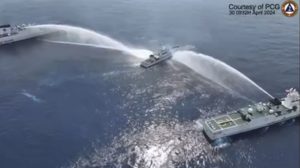Chinese coast guard ships have again fired high-pressure water cannons at two Philippine patrol vessels near the disputed Scarborough Shoal in the South China Sea, the Philippine government said yesterday, in the latest in a long line of incidents.
Philippine Coast Guard (PCG) spokesperson Jay Tarriela said in a statement that the PCG vessel BRP Bagacay and fishery patrol ship BRP Bankaw were carrying out “a legitimate maritime patrol” in the waters near Scarborough Shoal when they “encountered dangerous maneuvers and obstruction from four China Coast Guard [CCG] vessels and six Chinese maritime militia vessels.”
Chinese vessels fired water cannons at the BRP Bankaw first, damaging its electrical, navigation, and radio systems, and afterwards at the BRP Bagacay, damaging part of its deck railing and a canopy, he said. A video shot by reporters on board the BRP Bankaw appears to show the ship colliding with a CCG vessel, which proceeds to fire its water cannon at the ship’s radar navigation system from close range.
In a separate statement, the country’s National Task Force for the West Philippine Sea described the Chinese behavior as “illegal and irresponsible,” and said that it “highlights its egregious disregard for the Philippines’ lawful exercise of its rights and entitlements in our own Exclusive Economic Zone,” or EEZ.
Scarborough Shoal, known to Manila as Baja de Masinloc, lies around 198 kilometers due west of Luzon island, well within the Philippines’ EEZ. But the triangular shoal fell under China’s control after a 10-week stand-off with the Philippines in 2012 and the CCG has maintained a permanent presence there ever since.
While the Chinese authorities had for a time permitted Filipino fishermen to visit the shoal, it has moved to restrict this access over the past 18 months, as the two nations have engaged in intense stand-offs across the South China Sea.
Tarriela added that the China Coast Guard had “once again installed a 380-meter floating barrier that covers the entire entrance of the shoal, effectively restricting access to the area.” Chinese authorities last year installed a similar barrier, which was subsequently removed by the PCG.
He added that despite the “harassment and provocative actions,” the Philippine vessels completed the patrol. “They were not deterred and will persist in carrying out their legitimate operations to support Filipino fishermen and ensure their safety,” he said.
China’s state media confirmed yesterday that Chinese ships had expelled two Philippine vessels that “intruded into the waters adjacent to Huangyan Dao,” as Beijing refers to the shoal. A spokesperson for the CCG China also confirmed the incident, defending its actions as “professional, standardized, and legal,” Radio Free Asia reported. The spokesperson added that the Philippines’ actions “infringe on China’s sovereignty and seriously violate international law and basic norms of international relations.”
This use of force by the CCG has become routine in the South China Sea, as Beijing has become more forceful about enforcing its expansive “nine-dash line” claims, particularly against the Philippines. Along with Scarborough Shoal, the other major flashpoint has been Second Thomas Shoal in the Spratly Islands, some 630 kilometers to the south, where the Philippines maintains an outpost in a grounded World War II-era warship. The past 18 months have seen repeated confrontations between CCG and Philippine vessels in the waters around the shoal, in which Chinese vessels have rammed and fired water cannons at PCG patrol boats and civilian supply vessels, in a bid to prevent them from resupplying the Philippine marines stationed on the shoal.
At the moment, it remains unclear whether this pattern of escalation will end. Philippine President Ferdinand Marcos Jr. has pledged not to cede “an inch” of Philippine territory to China, while Beijing continues to treat Manila and its claims with haughty disdain.
While the current Chinese actions are calibrated to fall short of acts of war, they have now repeatedly resulted in substantial material damage to Philippine vessels, the prospect that one of these incidents could prompt a more significant clash cannot be discounted. The United States government has affirmed on numerous occasions that any armed Chinese attack on Philippine territory, vessels, or personnel in the South China Sea will oblige it to come to the Philippines’ aid under the 1951 Mutual Defense Treaty.
To an extent, of course, the distinction between acts of “enforcement” and acts of war is a semantic one – a high-pressure water cannon is in many functional senses a weapon – but with diplomatic efforts to resolve the stand-off seemingly stalled, this question could determine whether or not the South China Sea disputes ultimately escalate into an armed conflict.

































